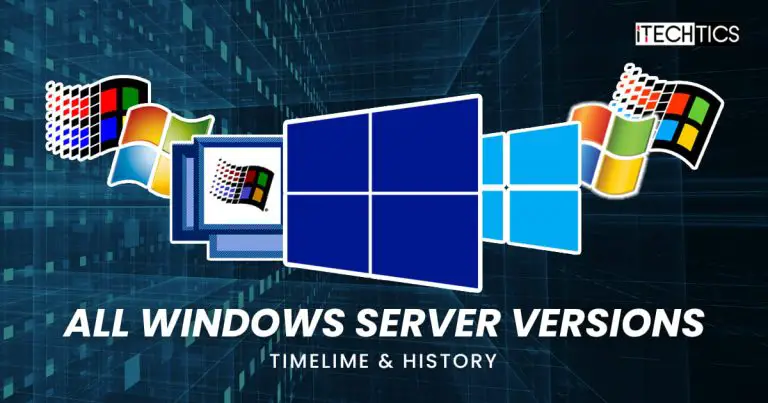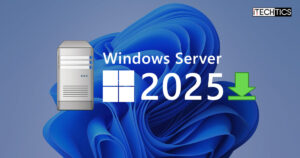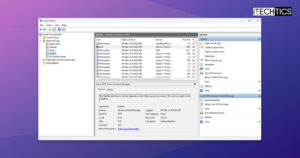Microsoft has been making client operating systems since 1985, when Windows 1.01 was first launched. However, the first server was not released till 1993 after the introduction of New Technology (NT). Since then, 14 different versions have been released (Windows Server 2022 is the latest version available at the time of writing this post).
Windows Servers are used for enterprise-level management, data storage, applications, and communications. Using this group of operating systems, administrators can apply and implement policies while enhancing their network’s security infrastructure.
In this post, we will discuss the different Windows Server versions, what unique feature(s) they brought, and in what order they were released.
Table of Contents
A common misunderstanding some people have is between the Server versions and their editions. The version of the server is either denoted by integers (this naming convention is no longer used) or suffixed with its corresponding year. For example, previously, Microsoft named a server version “Windows NT 3.5” or “Windows NT 4.0.” Now, they use “Windows Server 2003” or “Windows Server 2019.”
If you are confusing this with the Server editions, click on the link to read more about it.
Windows Server Timeline
The image below illustrates when a Windows Server version was initially released. You can then continue to read below to understand how each of these is different.

Windows Server History
The table below briefly describes the important aspects of each of the Windows Server versions along with some other useful information.Server Version Release Year Editions Currently Supported Details Windows NT 3.1 1993 – No First Server version. 32-bit. Windows NT 3.5 1994 – No Supports Unix and Novell Netware connectivity. Can be used with existing networks. Windows NT 3.51 1995 – No Support for Windows 95 with remote software license management. Windows NT 4.0 1996 – No With IIS, Server-edition Terminal, UI similar to Windows 95 Server 2000 2000 Server, Advanced Server, Datacenter Server No Integration with Active Directory for user authentication and support for Extensible Market Language. Server 2003 2003 Web, Standard, Enterprise, Datacenter No Define Server roles and features, inclusion of .NET. Server 2003 R2 2005 Web, Standard, Enterprise, Datacenter No With Active Directory Federation Services (ADFS), a Security configuration wizard, and improved data compression capabilities. Server 2008 2008 Web, Foundation, Standard, Enterprise, Datacenter No Introduced Hyper-Virtualization, Event Viewer, and Server Manager. Server 2008 R2 2009 Web, Foundation, Standard, Enterprise, Datacenter No 64-bit OS, enhanced Group Policy implementation, with Remote Desktop Services. Server 2012 2012 Foundation, Essentials, Standard, Datacenter Mainstream ended, extended ending October 2023 Improved Hyper-V functionality and support added for cloud integration Server 2012 R2 2013 Foundation, Essentials, Standard, Datacenter Mainstream ended, extended ending October 2023 Windows PowerShell updated and improved storage management. Server 2016 2016 Essentials, Standard, Datacenter Mainstream ended, extended ending January 2027 Inclusion of Network Controller and Nano Server, support for containers added. Server 2019 2018 Essentials, Standard, Datacenter Yes With Hyper-converged infrastructure, Advanced Threat Protection, and Windows Admin Center. Server 2022 2021 Essentials, Standard, Datacenter, Azure edition Yes With Azure Arc, Storage Migration Service, support for hot-patching.
The table above briefly describes all the significant changes as well as the release details of individual Windows Server versions since Microsoft first launched the operating system back in 1993.
Let us now dig into the details of each version.
Windows Server NT Versions
Initially, Microsoft used the New Technology (NT) terminology when releasing Windows Server. Moreover, the first version ever to be released publicly wasn’t version 1, but it was 3.1.
Another thing to note is that the different editions of each version did not kick in until 2000, with Windows Server 2000. Before that, Servers were only offered as a single, standard edition.
Windows NT Server 3.1
Windows NT Server 3.1 was the first Server by Microsoft. This was an operating system with a 32-bit architecture that was released in 1993. This was released in 2 variants: one for Terminals and another for Servers.
The version for Servers is what evolved into the Server family which continues to date.
Windows NT Server 3.5
Microsoft then skipped directly to version 3.5. Since most networks ran Unix or Novell servers, Windows NT Server 3.5 allowed interconnectivity with these systems for convenient data transmission.
This was a major feature for the sustainability of NT Servers since they were relatively new to the market.
Windows NT Server 3.51
Windows NT Server 3.51 had the capabilities to manage computers running Windows 95 on the same network. Server 3.51 also supported the management of software licenses for client computers and update other Windows 95 machines over the network.
Windows NT Server 4.0
This Server version included a UI similar to Windows 94 and was released in 1996. This included the Internet Information Server (IIS) which was in direct competition with Apache HTTP Server.
Furthermore, Microsoft also added the Transaction Server and the Message Queue Server to improve the OS. In the end, Microsoft improved the connectivity to non-Windows systems and also created a bridge from 16-bit DOS applications so that they could interface with the 32-bit Desktop environment.
Rebranded Windows Server Versions
In 2000, Microsoft dropped the “NT” version naming convention and shifted to a year-based release name. For example, “Windows Server 2000” was released in the year 2000.
Windows Server 2000
Windows Server 2000 was a major milestone for Microsoft since many of the features are still in use today by modern versions of the Server.
Windows Server 2000 included support for XML, creation of Active Server Pages (ASP), and the use of Active Directory for user authentication. It also introduced the concept of tailored editions, which included the standard Windows Server, Microsoft released Advanced Server, and Datacenter Server.
Editions: Server, Advanced Server, Datacenter Server
Windows Server 2003
The major change in Server 2003 was the reduction of system reboot requirements after an event. Microsoft also enhanced the security features of the operating system, and this was the first time that the .NET environment was included with the Windows Server operating system.
It was also the first time a Server was able to assign server roles, enabling the operating system to be tailored to specific specialized tasks, such as a DNS server.
Editions: Web, Standard, Enterprise, Datacenter
Windows Server 2003 R2
This was Revision 2 (R2) of Windows Server 2003. This allowed users with valid licenses for Server 2003 to automatically upgrade to Server 2003 R2 without any additional costs.
This version mostly focused on enhancing the security of the OS as well as the network. It introduced Active Directory Federation Services (ADFS) for user authentication. The purpose of this AD extension was to enable external services to be included in the “single sign-on” permissions managed within the network.
Another improvement to this version was the Active Directory Application Mode, which improved security by creating an “arm’s length” relationship with third-party applications – it did not trust the apps that well.
Furthermore, administrators were now able to apply and implement Group Policies on other users and computers using the Security Configuration Wizard.
Editions: Web, Standard, Enterprise, Datacenter
Windows Server 2008
Windows Server 2008 was the first Server OS to include a Hyper-V virtualization system, upon which users can implement Virtual Machines (VMs) and install operating systems. Furthermore, the inclusion of the Event Viewer and the Server Manager made it easier for the administrators to troubleshoot any issues and then manage their Servers more conveniently.
Not only that, but Microsoft went a step ahead and also introduced the Core version of Windows Server 2008, which was a command line-based OS with a bare minimum User Interface (UI).
Editions: Web, Foundation, Standard, Enterprise, Datacenter
Windows Server 2008 R2
This was the first Server to have a 64-bit architecture. Windows Server 2008 R2 made significant improvements to the Active Directory Group Policy implementation, with the inclusion of new policies. It also included Remote Desktop Services for the very first time on a Server OS.
Editions: Web, Foundation, Standard, Enterprise, Datacenter
Windows Server 2012
Windows Server 2012 included better features for off-site server integration. This was mainly done by Microsoft so it can be integrated with cloud servers and services. Furthermore, they also updated the storage system with this OS, which was mediated by Hyper-V itself.
Not only that, but the Hyper-V virtual switch and Hyper-V Replica were also introduced in Server 2012.
Editions: Foundation, Essentials, Standard, Datacenter
Windows Server 2012 R2
This revision to Server 2012 made further improvements to the cloud integration. It also included updates to Windows PowerShell. Virtualization and storage technologies were also overhauled and the Web services were enhanced.
Editions: Foundation, Essentials, Standard, Datacenter
Windows Server 2016
Server 2012 introduced the Nano Server – a minimal, lightweight server implementation to minimize the attack surface. An encryption system was also added for Hyper-V to secure the VMs.
Another milestone for Microsoft was the support for containers.
That said, at this point, Microsoft discontinued R2 versions of the Servers as they had shifted to the Long-Term Servicing Channel (LTSC).
Server 2016 also included the Network Controller. This enabled administrators to manage both physical as well as virtual network devices using a single console. However, this feature is only available in the Datacenter edition.
Editions: Essentials, Standard, Datacenter
Windows Server 2019
Previously known as Project Honolulu, Windows Admin Center was launched for the first time and is an integrated all-in-one console to manage your Active Directory. Integrated servers, machines, and users can also be managed using this one console only, along with services and server roles.
It also includes Hyperconvereged Infrastructure (HCI) capabilities which is a software that combines all of the basic data center elements, such as computing, storage, networking, and management, into a single software. This facility aims to obtain all the functions of a miniature data center without the additional hardware costs.
You can read more about other enhancements and improvements in our post for Server 2019.
Editions: Essentials, Standard, Datacenter
Windows Server 2022
Windows Server 2022 is the latest version of Server at the time of writing this post.
This includes Azure Arc, which is used to manage and govern on-prem servers within Microsoft Azure. Furthermore, it also includes support for hotpatching – which is installing updates without having to reboot the target PC.
Improvements to networking have also been improved by the inclusion of software-defined networking capabilities. Supports SMB over QUIC capability for safer communications. It’s designed for VPN replacement and relies on UDP and TLS 1.3 protocols for faster and safer communication.
You can read more about other enhancements and improvements in our post for Server 2022.
Editions: Essentials, Standard, Datacenter, Datacenter: Azure edition
Windows Server 2025
Windows Server 2025 introduces features such as hotpatching, which allows for applying updates without restarting, and enhanced NVMe performance for better storage handling.
It also includes updates to Active Directory and SMB protocols, improving security and efficiency. It’s still in Public Preview and will be released soon. You can download Windows Server 2025 now.
Final Thoughts
Windows Server has come a long way since its debut in 1993. This has improved UI as well as many other functional improvements for manageability. Such improvements are the reason why Microsoft releases new versions every few years – so organizations can take advantage of the new features.
Each of these versions then had different variants, which are known as editions. You may click on the link to learn about the different editions and how they differ from one another. But it doesn’t end here.
The Datacenter and Standard editions also come with different variants – which are the Core and Desktop Experience variants.
To sum up, the complete name of a Windows Server operating system can be as such: Windows Server 2022 Datacenter Core Evaluation. This means that the version is Server 2022, the edition is Datacenter with the bare minimum UI (Core), and is the Evaluation edition and only valid for a total of 180 days since its installation.







